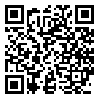Volume 5, Issue 1 (Continuously Updated 2022)
Func Disabil J 2022, 5(1): 0-0 |
Back to browse issues page
Download citation:
BibTeX | RIS | EndNote | Medlars | ProCite | Reference Manager | RefWorks
Send citation to:



BibTeX | RIS | EndNote | Medlars | ProCite | Reference Manager | RefWorks
Send citation to:
Asharlous A, Riazi A, Janani S, Rajabi S, Rakhshan A, Khabazkhoob M, et al . Refractive Error and Ocular Biometric Changes in the Treatment of Diabetes Mellitus. Func Disabil J 2022; 5 (1) : 60
URL: http://fdj.iums.ac.ir/article-1-192-en.html
URL: http://fdj.iums.ac.ir/article-1-192-en.html
Amir Asharlous1 

 , Abbas Riazi1
, Abbas Riazi1 

 , Samira Janani1
, Samira Janani1 

 , Sattar Rajabi *2
, Sattar Rajabi *2 

 , Amir Rakhshan3
, Amir Rakhshan3 

 , Mehdi Khabazkhoob4
, Mehdi Khabazkhoob4 

 , Zahra Sadat Dibaji Forooshani5
, Zahra Sadat Dibaji Forooshani5 

 , Hamed Tabesh6
, Hamed Tabesh6 




 , Abbas Riazi1
, Abbas Riazi1 

 , Samira Janani1
, Samira Janani1 

 , Sattar Rajabi *2
, Sattar Rajabi *2 

 , Amir Rakhshan3
, Amir Rakhshan3 

 , Mehdi Khabazkhoob4
, Mehdi Khabazkhoob4 

 , Zahra Sadat Dibaji Forooshani5
, Zahra Sadat Dibaji Forooshani5 

 , Hamed Tabesh6
, Hamed Tabesh6 


1- Department of Optometry, Rehabilitation Research Center, School of Rehabilitation Sciences, Iran University of Medical Sciences, Tehran, Iran.
2- Department of Optometry, Rehabilitation Research Center, School of Rehabilitation Sciences, Iran University of Medical Sciences, Tehran, Iran. ,sattar.rajabi@yahoo.com
3- Department of Foreign Languages, Faculty of Foreign Languages and Literatures, Tehran University of Medical Sciences, Tehran, Iran.
4- Department of Basic Sciences, School of Nursing and Midwifery, Shahid Beheshti University of Medical Sciences, Tehran, Iran.
5- Bank Melli Hospital, Tehran, Iran.
6- Department of Medical Informatics, School of Medicine, Mashhad University of Medical Sciences, Mashhad, Iran.
2- Department of Optometry, Rehabilitation Research Center, School of Rehabilitation Sciences, Iran University of Medical Sciences, Tehran, Iran. ,
3- Department of Foreign Languages, Faculty of Foreign Languages and Literatures, Tehran University of Medical Sciences, Tehran, Iran.
4- Department of Basic Sciences, School of Nursing and Midwifery, Shahid Beheshti University of Medical Sciences, Tehran, Iran.
5- Bank Melli Hospital, Tehran, Iran.
6- Department of Medical Informatics, School of Medicine, Mashhad University of Medical Sciences, Mashhad, Iran.
Abstract: (1453 Views)
Background and Objectives: Evaluation of changes in refractive errors and biometric parameters in the process of glycemic control in people with type 2 diabetes during three-month treatment.
Methods: Patients with the first diagnosis of type 2 diabetes or a history of poor glycemic control (hemoglobin glycate more than 7.5%) and without any systemic disease other than diabetes were included. Hemoglobin glycate, refractive error, and biometric parameters were evaluated before treatment and one and a half and three months after treatment, and their changes were examined by generalized estimating equation (GEE) analysis.
Results: A total of 60 eyes of 30 patients with a mean age of 51.63±6.79 years were evaluated. Hemoglobin glycate decreased by an average of 1.028% compared to the baseline measurement in the third month (P<0.001). Mean spherical (P=0.554), spherical equivalent (P=0.340), axial length (P=0.147), and anterior chamber depth (P=0.336) did not show a significant difference between the three examinations. In contrast, the lens thickness showed a significant decrease during treatment (P=0.001). Finally, generalized estimating equation (GEE) analysis showed that a 1% decrease in hemoglobin glycate increased by 0.226 mm. (P=0.002) in the axial length. It should be mentioned in tables FU1means Follow-up 1.5 months and FU2 means Follow-up 3 months.
Conclusion: The present study shows that refractive errors and most ocular biometric parameters do not change significantly compared to the baseline levels in the period of one and a half and three months after the start of glycemic control.
Methods: Patients with the first diagnosis of type 2 diabetes or a history of poor glycemic control (hemoglobin glycate more than 7.5%) and without any systemic disease other than diabetes were included. Hemoglobin glycate, refractive error, and biometric parameters were evaluated before treatment and one and a half and three months after treatment, and their changes were examined by generalized estimating equation (GEE) analysis.
Results: A total of 60 eyes of 30 patients with a mean age of 51.63±6.79 years were evaluated. Hemoglobin glycate decreased by an average of 1.028% compared to the baseline measurement in the third month (P<0.001). Mean spherical (P=0.554), spherical equivalent (P=0.340), axial length (P=0.147), and anterior chamber depth (P=0.336) did not show a significant difference between the three examinations. In contrast, the lens thickness showed a significant decrease during treatment (P=0.001). Finally, generalized estimating equation (GEE) analysis showed that a 1% decrease in hemoglobin glycate increased by 0.226 mm. (P=0.002) in the axial length. It should be mentioned in tables FU1means Follow-up 1.5 months and FU2 means Follow-up 3 months.
Conclusion: The present study shows that refractive errors and most ocular biometric parameters do not change significantly compared to the baseline levels in the period of one and a half and three months after the start of glycemic control.
Article number: 60
Type of Study: Research |
Subject:
Optometry
Received: 2022/12/13 | Accepted: 2023/02/13 | Published: 2022/02/3
Received: 2022/12/13 | Accepted: 2023/02/13 | Published: 2022/02/3





